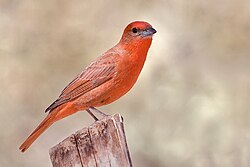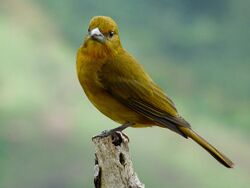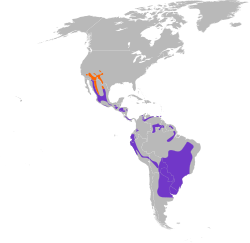Biology:Hepatic tanager
| Hepatic tanager | |
|---|---|

| |
| Northern hepatic tanager, Piranga flava hepatica | |

| |
| female | |
| Scientific classification | |
| Domain: | Eukaryota |
| Kingdom: | Animalia |
| Phylum: | Chordata |
| Class: | Aves |
| Order: | Passeriformes |
| Family: | Cardinalidae |
| Genus: | Piranga |
| Species: | P. flava
|
| Binomial name | |
| Piranga flava (Vieillot, 1822)
| |

| |
| Synonyms | |
|
Piranga hepatica | |
The hepatic tanager (Piranga flava) is a medium-sized American songbird. Formerly placed in the tanager family (Thraupidae), it and other members of the genus Piranga are now classified in the cardinal family (Cardinalidae).[2] The species's plumage and vocalizations are similar to other members of the cardinal family.
Etymology and taxonomy
The common name hepatic means "liver-coloured", namely, brownish-red.[3] The specific name flāva is Latin for yellow or golden.
There are three subspecies groups, which may be separate species:
- the hepatica group, breeding from Nicaragua north, in pine and pine-oak forests and partially migratory
- the lutea group (sometimes known as the tooth-billed tanager),[4] resident from Costa Rica to northern and western South America in highland forest edges
- the flava group (sometimes known as the red tanager),[4] resident in open woods elsewhere in South America[5]
Description
Members of the northern group are larger and stockier than other Piranga tanagers and have a relatively short tail and a stout bill. Its brightest color is always on its forehead and throat. In all plumages, it has gray flanks, dusky cheeks, and a dark eye streak. The female is yellow, and the male is red. Its average weight is 38 g (1.3 oz). Its average wingspan is 31.8 cm (12.5 in) and length is 20.3 cm (8.0 in).[6]
Distribution and habitat
It ranges from the southwestern United States (Arizona, New Mexico, and locally in southern California and Colorado) to northern Argentina and Uruguay.
Behavior
The habits of the hepatic tanager are similar to those of the western tanager.[6]
Its call is a low, dry chup like the hermit thrush. Its song is clearer than Thraupidae tanagers and far more similar to the song of the black-headed grosbeak, another member of the Cardinalidae. The flight call is a husky and rising weet.[6]
It looks for food in the foliage of trees, moving slowly and methodically; different individuals use different strategies. In summer, the northern form largely eats insects, spiders and some fruit. In Mexico, it has been observed to eat nectar. From Oaxaca south, it follows swarms of army ants.[5]
Even the northern population's behavior and life history are remarkably little known.[5]
References
- ↑ BirdLife International (2017). "Piranga flava". IUCN Red List of Threatened Species 2017: e.T103811599A119471621. doi:10.2305/IUCN.UK.2017-3.RLTS.T103811599A119471621.en. https://www.iucnredlist.org/species/103811599/119471621. Retrieved 19 November 2021.
- ↑ Remsen, J.V. Jr.; Cadena, C.D.; Jaramillo, A.; Nores, M.; Pacheco, J.F.; Robbins, M.B.; Schulenberg, T.S.; Stiles, F.G. et al.. "A classification of the bird species of South America". American Ornithologists' Union: South American Checklist Committee. http://www.museum.lsu.edu/~Remsen/SACCBaseline11.htm.
- ↑ hepatic (3rd ed.), Oxford University Press, September 2005, http://oed.com/search?searchType=dictionary&q=hepatic (Subscription or UK public library membership required.)
"(adj.) Liver-coloured, dark brownish-red; as in hepatic aloes, hepatic tanager." - ↑ 4.0 4.1 Gill, Frank; Donsker, David, eds. "IOC World Bird List". http://www.worldbirdnames.org/.
- ↑ 5.0 5.1 5.2 Eddleman, William R. (2002). "Hepatic Tanager (Piranga flava)". The Birds of North America Online. Ithaca: Cornell Lab of Ornithology. http://bna.birds.cornell.edu/bna/species/655.
- ↑ 6.0 6.1 6.2 Sibley, David (2003). The Sibley Field Guide to Birds of Western North America. ISBN 0-679-45121-8.
External links
- Hepatic tanager Species Account – Cornell Lab of Ornithology
- Hepatic tanager Stamps[Usurped!] from Paraguay at bird-stamps.org[Usurped!]
- Hepatic tanager photo gallery at VIREO (Drexel University)
- "Lowland hepatic tanager media". Internet Bird Collection. http://www.hbw.com/ibc/species/lowland-hepatic-tanager-piranga-flava.
Wikidata ☰ {{{from}}} entry
 |


